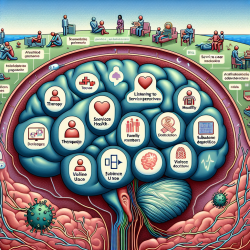Introduction
In the realm of speech-language pathology and beyond, the intersection of mental health and houselessness presents a critical area for research and intervention. A recent study titled Disparities in the Prevalence of Psychiatric Illness in Hawaii's Houseless Population: A Retrospective Chart Review sheds light on the unique challenges faced by Hawaii's houseless population, particularly in terms of psychiatric disorders and ethnic disparities. This blog aims to provide practitioners with insights from this study to enhance their practice and encourage further research.
Understanding the Study
The study conducted a retrospective chart review of records from one of Oahu's major houseless outreach clinics. It aimed to identify disparities in psychiatric disorder prevalence among different ethnic groups within Hawaii's houseless population. The findings revealed unexpected trends, such as lower reported rates of certain psychiatric diagnoses among houseless Pacific Islander groups, despite being identified as high risk by other studies. These findings suggest potential underdiagnosis and highlight the need for culturally competent care.
Key Findings and Implications
- Higher Rates of Serious Mental Illnesses: The study found higher rates of serious mental illnesses, such as bipolar disorder and schizophrenia, among the houseless compared to the general population. This underscores the need for targeted mental health interventions.
- Unexpectedly Low Prevalence of Other Disorders: Certain psychiatric diagnoses, such as anxiety and depression, were found to be less prevalent among the houseless. This may indicate underdiagnosis due to cultural or social barriers.
- Ethnic Disparities: The study highlighted significant ethnic disparities in mental health diagnoses, with Caucasians reporting higher rates of anxiety and PTSD compared to other ethnic groups. This suggests the need for tailored interventions that consider ethnic and cultural factors.
Recommendations for Practitioners
Practitioners working with houseless populations should consider the following strategies to improve mental health outcomes:
- Implement Routine Mental Health Screenings: Utilize efficient screening tools such as the Patient Health Questionnaire-2 (PHQ-2) for depression and the Generalized Anxiety Disorder 2-item (GAD-2) for anxiety.
- Enhance Cultural Competency: Develop a deeper understanding of the cultural and social contexts of different ethnic groups to provide more effective and sensitive care.
- Address Barriers to Care: Work to reduce stigma and improve access to mental health services for houseless individuals, particularly among minority groups.
Encouraging Further Research
The findings from this study highlight the need for further research into the mental health needs of Hawaii's houseless population. Future studies should explore the use of standardized screening tools and investigate culturally sensitive approaches to mental health care. By advancing our understanding of these issues, we can better support houseless individuals and work towards more equitable health outcomes.
To read the original research paper, please follow this link: Disparities in the Prevalence of Psychiatric Illness in Hawaii's Houseless Population: A Retrospective Chart Review.










